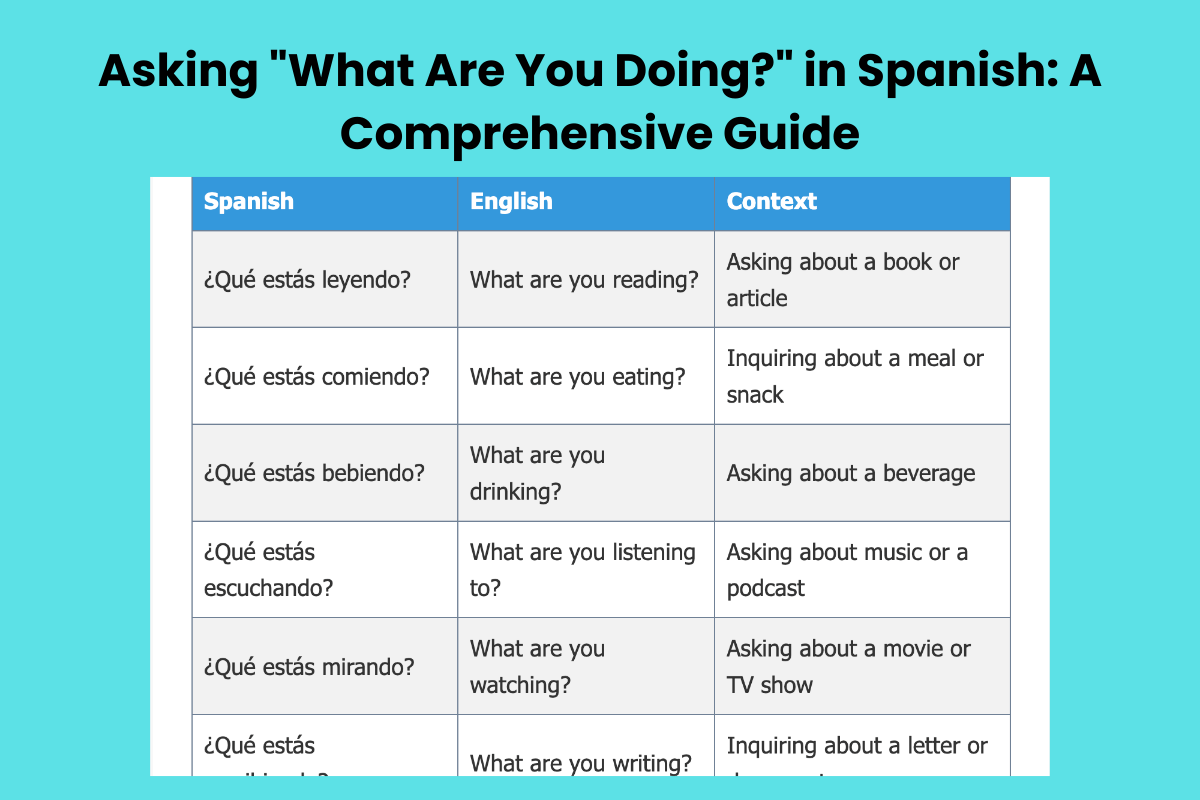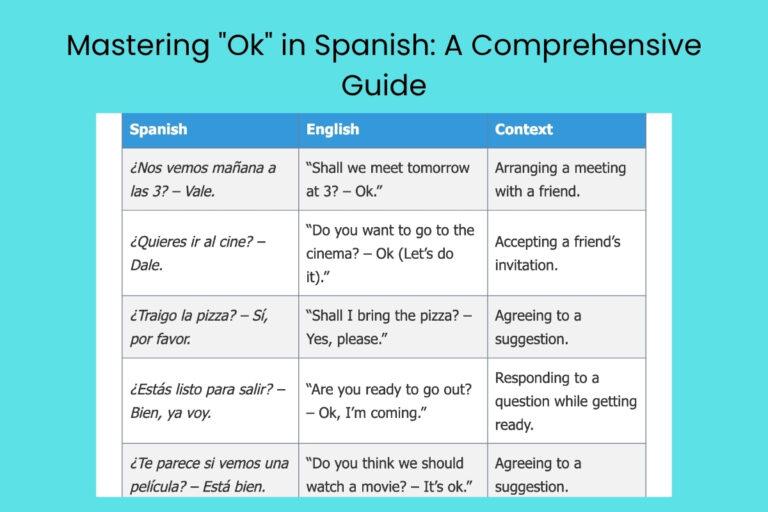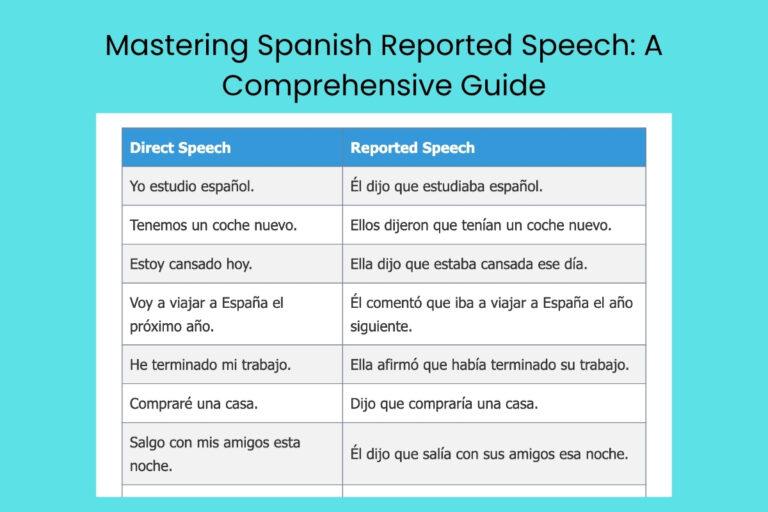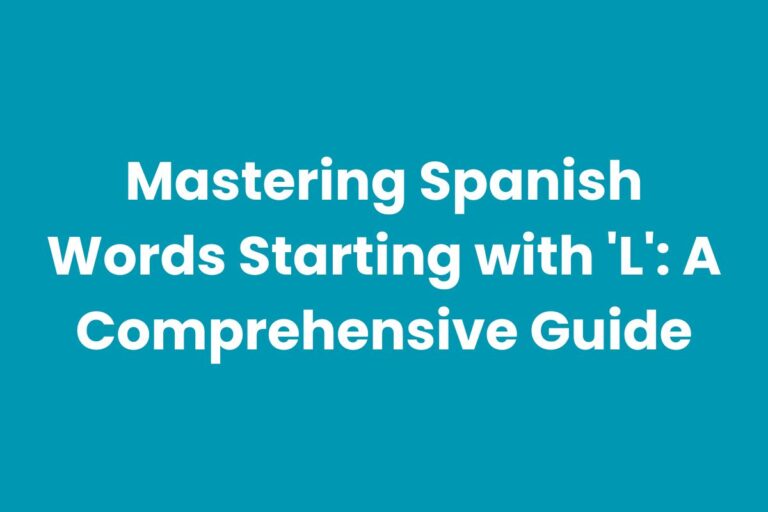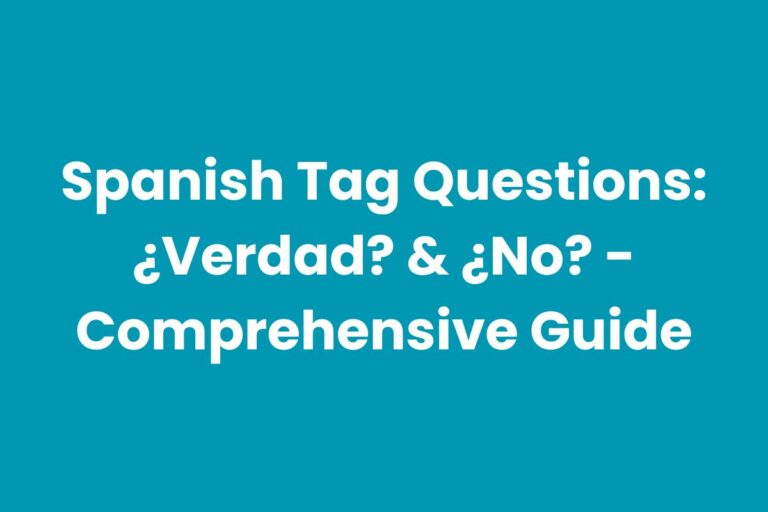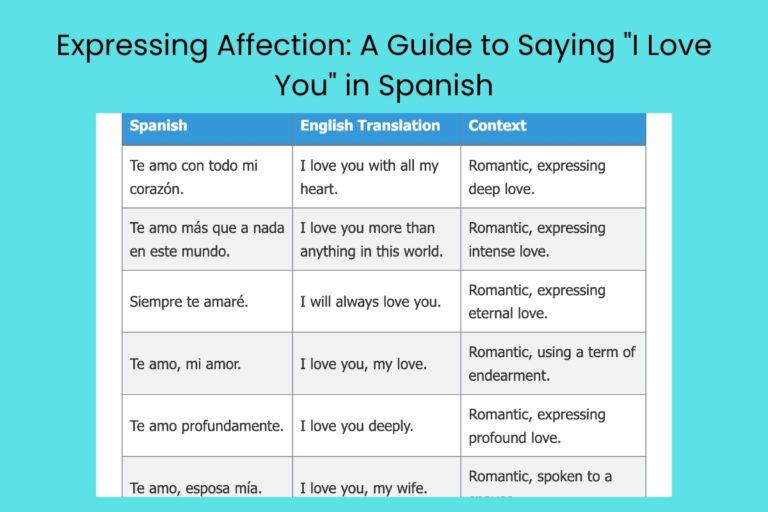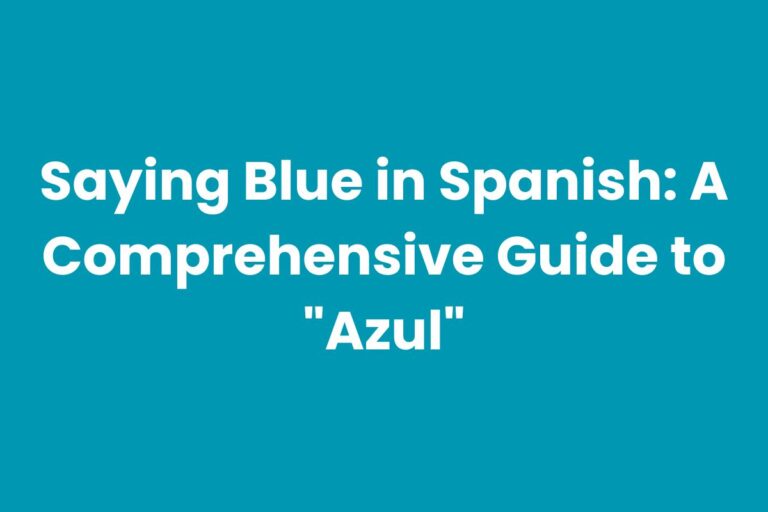Asking “What Are You Doing?” in Spanish: A Comprehensive Guide
Understanding how to ask “What are you doing?” in Spanish is crucial for basic communication and engaging in everyday conversations. This seemingly simple question opens doors to understanding actions, making plans, and building relationships with Spanish speakers.
Mastering this phrase and its variations will significantly enhance your ability to interact in Spanish-speaking environments. This guide is designed for learners of all levels, from beginners to advanced students, providing a detailed breakdown of the grammar, usage, and nuances of this essential question.
Table of Contents
- Introduction
- Definition: “¿Qué estás haciendo?”
- Structural Breakdown
- Types and Categories
- Examples
- Usage Rules
- Common Mistakes
- Practice Exercises
- Advanced Topics
- FAQ
- Conclusion
Definition: “¿Qué estás haciendo?”
The phrase “¿Qué estás haciendo?” directly translates to “What are you doing?” in English. It is a question used to inquire about someone’s current activity or action in progress. Grammatically, it employs the present progressive tense in Spanish, which is formed using the verb estar (to be) and the present participle (gerund) of the main verb. This construction indicates that the action is happening at the moment of speaking.
The function of this question is primarily to gather information about someone’s present activity. It can also serve as an icebreaker, a way to show interest in someone’s life, or a prelude to making plans.
The context in which it’s used can vary widely, from casual conversations with friends to more formal interactions with acquaintances.
Structural Breakdown
The structure of “¿Qué estás haciendo?” is relatively straightforward. Let’s break it down:
- ¿Qué?: This is the interrogative pronoun meaning “what?” It initiates the question and directs the focus towards the action being performed.
- estás: This is the second-person singular (tú form) of the verb estar, which means “to be.” In the present progressive tense, estar acts as an auxiliary verb.
- haciendo: This is the present participle (gerund) of the verb hacer, which means “to do” or “to make.” The present participle indicates that the action is ongoing.
Therefore, the complete structure follows the pattern: Interrogative Pronoun + Conjugated Estar + Present Participle. This structure is consistent for forming questions in the present progressive tense in Spanish.
Types and Categories
Formal vs. Informal
While “¿Qué estás haciendo?” is generally considered informal because it uses the tú form, there are formal alternatives. To ask someone “What are you doing?” in a formal setting, you would use the usted form:
- ¿Qué está haciendo?: This is the formal equivalent, using the third-person singular conjugation of estar (está) to address someone with respect.
The choice between the formal and informal form depends on your relationship with the person you are addressing and the context of the conversation. Use the formal form with people you don’t know well, elders, or in professional settings.
Variations of the Question
There are several variations of “¿Qué estás haciendo?” that you can use to express similar ideas or to gather more specific information. Some common variations include:
- ¿Qué haces?: This translates to “What do you do?” and is used to ask about someone’s general activities or habits rather than what they are doing at the precise moment.
- ¿Qué vas a hacer?: This translates to “What are you going to do?” and is used to inquire about someone’s future plans.
- ¿En qué estás?: This translates to “What are you working on?” or “What are you up to?” and is used to ask about someone’s current project or task.
These variations allow you to tailor your question to the specific situation and the information you are seeking.
Examples
Present Progressive Examples
The following table provides a comprehensive list of examples using the present progressive tense to ask “What are you doing?” in various contexts.
| Spanish | English | Context |
|---|---|---|
| ¿Qué estás leyendo? | What are you reading? | Asking about a book or article |
| ¿Qué estás comiendo? | What are you eating? | Inquiring about a meal or snack |
| ¿Qué estás bebiendo? | What are you drinking? | Asking about a beverage |
| ¿Qué estás escuchando? | What are you listening to? | Asking about music or a podcast |
| ¿Qué estás mirando? | What are you watching? | Asking about a movie or TV show |
| ¿Qué estás escribiendo? | What are you writing? | Inquiring about a letter or document |
| ¿Qué estás pensando? | What are you thinking about? | Asking about someone’s thoughts |
| ¿Qué estás buscando? | What are you looking for? | Asking about a lost item |
| ¿Qué estás cocinando? | What are you cooking? | Asking about a meal being prepared |
| ¿Qué estás aprendiendo? | What are you learning? | Inquiring about a subject of study |
| ¿Qué estás enseñando? | What are you teaching? | Asking about a subject being taught |
| ¿Qué estás jugando? | What are you playing? | Asking about a game |
| ¿Qué estás planeando? | What are you planning? | Inquiring about future events |
| ¿Qué estás celebrando? | What are you celebrating? | Asking about a special occasion |
| ¿Qué estás construyendo? | What are you building? | Inquiring about a project |
| ¿Qué estás reparando? | What are you repairing? | Asking about a broken item |
| ¿Qué estás limpiando? | What are you cleaning? | Asking about a cleaning task |
| ¿Qué estás organizando? | What are you organizing? | Inquiring about a sorting task |
| ¿Qué estás empacando? | What are you packing? | Asking about luggage |
| ¿Qué estás desempolvando? | What are you dusting? | Inquiring about a cleaning task |
| ¿Qué estás regando? | What are you watering? | Asking about plants |
| ¿Qué estás podando? | What are you pruning? | Inquiring about gardening |
| ¿Qué estás diseñando? | What are you designing? | Asking about a project |
| ¿Qué estás dibujando? | What are you drawing? | Inquiring about artwork |
| ¿Qué estás pintando? | What are you painting? | Asking about artwork |
| ¿Qué estás cosiendo? | What are you sewing? | Inquiring about a garment |
| ¿Qué estás tejiendo? | What are you knitting? | Asking about a knitted item |
| ¿Qué estás grabando? | What are you recording? | Inquiring about audio or video |
This table illustrates the versatility of the present progressive tense in asking about ongoing activities. By changing the verb, you can inquire about a wide range of actions.
Alternative Phrases Examples
The table below provides examples of alternative phrases that can be used to ask “What are you doing?” or similar questions in Spanish.
| Spanish | English | Context |
|---|---|---|
| ¿Qué haces? | What do you do? / What are you doing? | General inquiry about activities |
| ¿Qué tal? | What’s up? | Casual greeting and inquiry |
| ¿Qué onda? | What’s up? (Mexico) | Casual greeting and inquiry (Mexican slang) |
| ¿Qué pasa? | What’s happening? | Inquiring about a situation |
| ¿Qué sucede? | What’s happening? (Formal) | More formal inquiry about a situation |
| ¿En qué andas? | What are you up to? | Inquiring about recent activities |
| ¿En qué estás metido/a? | What are you involved in? | Inquiring about a project or activity |
| ¿Qué estás tramando? | What are you plotting? | Playful inquiry about plans |
| ¿Qué te traes entre manos? | What do you have up your sleeve? | Inquiring about a secret plan |
| ¿Qué tienes ahí? | What do you have there? | Inquiring about a visible object |
| ¿Qué te cuentas? | What’s new? | Inquiring about recent news |
| ¿Qué novedades hay? | What’s new? (Formal) | More formal inquiry about recent news |
| ¿Qué se dice? | What’s being said? / What’s up? | Inquiring about gossip or news |
| ¿A qué te dedicas? | What do you do for a living? | Inquiring about someone’s job |
| ¿Qué te trae por aquí? | What brings you here? | Inquiring about someone’s presence |
| ¿Qué te ocupa? | What’s keeping you busy? | Inquiring about someone’s tasks |
| ¿Qué te preocupa? | What’s worrying you? | Inquiring about someone’s concerns |
| ¿Qué te divierte? | What amuses you? | Inquiring about someone’s hobbies |
| ¿Qué te interesa? | What interests you? | Inquiring about someone’s interests |
| ¿Qué te motiva? | What motivates you? | Inquiring about someone’s drives |
| ¿Qué te apasiona? | What are you passionate about? | Inquiring about someone’s passions |
| ¿Qué te entretiene? | What entertains you? | Inquiring about someone’s leisure |
| ¿Qué estás pensando hacer hoy? | What are you planning to do today? | Inquiring about daily plans |
| ¿Qué tienes en mente? | What’s on your mind? | Inquiring about someone’s thoughts |
| ¿Qué tienes pensado para el fin de semana? | What are your plans for the weekend? | Inquiring about weekend plans |
| ¿Qué tienes planeado para las vacaciones? | What are your plans for the holidays? | Inquiring about holiday plans |
This table provides a variety of ways to ask about someone’s activities, plans, or thoughts, expanding your conversational repertoire.
Usage Rules
Tense Agreement
When asking “¿Qué estás haciendo?”, ensure that the tense of your question aligns with the tense of the expected answer. The present progressive tense indicates an action in progress at the moment of speaking.
Therefore, the response should also be in the present progressive or a closely related tense.
For example:
- Question: ¿Qué estás haciendo? (What are you doing?)
- Answer: Estoy leyendo un libro. (I am reading a book.)
Avoid answering with a simple present tense if the question is in the present progressive, as it may not accurately reflect the ongoing nature of the activity.
Pronoun Usage
As mentioned earlier, “¿Qué estás haciendo?” uses the informal tú form. When addressing someone formally, use “¿Qué está haciendo?” with the usted form. Be mindful of the appropriate pronoun based on your relationship with the person.
Consider these examples:
- Informal: ¿Qué estás haciendo, Juan? (What are you doing, Juan?)
- Formal: ¿Qué está haciendo, Señor Pérez? (What are you doing, Mr. Pérez?)
Using the correct pronoun demonstrates respect and cultural sensitivity.
Contextual Appropriateness
Be mindful of the context in which you ask “¿Qué estás haciendo?”. In some situations, it may be perceived as intrusive or nosy.
Consider your relationship with the person and the circumstances before asking the question.
For instance, asking a busy colleague “¿Qué estás haciendo?” during a critical project deadline might be inappropriate. However, asking a friend the same question during a casual conversation is perfectly acceptable.
Common Mistakes
Here are some common mistakes to avoid when asking “¿Qué estás haciendo?” in Spanish:
| Incorrect | Correct | Explanation |
|---|---|---|
| ¿Qué haces ahora? | ¿Qué estás haciendo ahora? | “¿Qué haces?” is for general actions, not current ones. |
| ¿Qué es haciendo? | ¿Qué estás haciendo? | The correct conjugation of “estar” for “tú” is “estás.” |
| ¿Qué haciendo? | ¿Qué estás haciendo? | The auxiliary verb “estar” is necessary. |
| ¿Qué está haciendo tú? | ¿Qué estás haciendo tú? / ¿Qué está haciendo usted? | Word order is incorrect. In formal contexts, use usted. |
| Estoy haciendo qué? | ¿Qué estás haciendo? | The word order for questions is different in Spanish. |
Avoiding these common mistakes will help you communicate more effectively and accurately in Spanish.
Practice Exercises
Exercise 1: Translation
Translate the following English sentences into Spanish using the present progressive tense.
| No. | English | Spanish (Answer) |
|---|---|---|
| 1 | What are you reading? | ¿Qué estás leyendo? |
| 2 | What are you eating? | ¿Qué estás comiendo? |
| 3 | What are you watching? | ¿Qué estás mirando? |
| 4 | What are you thinking about? | ¿Qué estás pensando? |
| 5 | What are you cooking? | ¿Qué estás cocinando? |
| 6 | What are you writing? | ¿Qué estás escribiendo? |
| 7 | What are you listening to? | ¿Qué estás escuchando? |
| 8 | What are you learning? | ¿Qué estás aprendiendo? |
| 9 | What are you playing? | ¿Qué estás jugando? |
| 10 | What are you planning? | ¿Qué estás planeando? |
Exercise 2: Fill in the Blanks
Complete the following Spanish sentences with the correct form of the verb estar and the present participle of the verb in parentheses.
| No. | Spanish (Fill in the Blanks) | Answer |
|---|---|---|
| 1 | ¿Qué tú (hacer)? | ¿Qué estás haciendo tú? |
| 2 | Yo (leer) un libro. | Yo estoy leyendo un libro. |
| 3 | Ella (comer) una manzana. | Ella está comiendo una manzana. |
| 4 | Nosotros (mirar) la televisión. | Nosotros estamos mirando la televisión. |
| 5 | Ellos (escribir) un correo electrónico. | Ellos están escribiendo un correo electrónico. |
| 6 | ¿Qué usted (pensar)? | ¿Qué está pensando usted? |
| 7 | Vosotros (escuchar) música. | Vosotros estáis escuchando música. |
| 8 | Él (cocinar) la cena. | Él está cocinando la cena. |
| 9 | Yo (aprender) español. | Yo estoy aprendiendo español. |
| 10 | Tú (jugar) al fútbol. | Tú estás jugando al fútbol. |
Exercise 3: Sentence Building
Create Spanish sentences using the given words to ask “What are you doing?” in different contexts. Use the present progressive tense.
| No. | Words | Spanish (Answer) |
|---|---|---|
| 1 | tú / leer / qué | ¿Qué estás leyendo tú? |
| 2 | usted / comer / qué | ¿Qué está comiendo usted? |
| 3 | ella / mirar / qué | ¿Qué está mirando ella? |
| 4 | nosotros / pensar / qué | ¿Qué estamos pensando nosotros? |
| 5 | ellos / escribir / qué | ¿Qué están escribiendo ellos? |
| 6 | él / cocinar / qué | ¿Qué está cocinando él? |
| 7 | yo / aprender / qué | ¿Qué estoy aprendiendo yo? |
| 8 | vosotros / jugar / qué | ¿Qué estáis jugando vosotros? |
| 9 | tú / planear / qué | ¿Qué estás planeando tú? |
| 10 | ustedes / celebrar / qué | ¿Qué están celebrando ustedes? |
Advanced Topics
Idiomatic Expressions
Spanish, like any language, has idiomatic expressions that convey the idea of “What are you doing?” in a more nuanced or colorful way. These expressions often don’t translate literally but are commonly used in specific regions or contexts.
Learning these expressions can add depth to your understanding of the language and make your conversations more engaging.
For example:
- ¿Qué mosca te picó?: This translates to “What fly bit you?” but is used to ask someone why they are acting strangely or irritably.
- ¿Qué bicho te picó?: Similar to the above, but using “bicho” (bug) instead of “mosca” (fly).
Regional Variations
The Spanish language varies significantly across different regions and countries. While “¿Qué estás haciendo?” is widely understood, some regions may prefer alternative phrases or have unique slang terms for asking about someone’s activities.
For instance, in some parts of Latin America, you might hear:
- ¿Qué onda? (Mexico): This is a casual way of saying “What’s up?” or “What’s going on?”
- ¿Qué haces? (General): While technically “What do you do?”, it’s often used interchangeably with “What are you doing?” in casual conversation.
Being aware of these regional variations can help you better understand and communicate with Spanish speakers from different backgrounds.
FAQ
- Is “¿Qué estás haciendo?” always informal?
Yes, “¿Qué estás haciendo?” is generally considered informal because it uses the tú form. To be formal, use “¿Qué está haciendo?” with the usted form.
- Can I use “¿Qué haces?” instead of “¿Qué estás haciendo?”
Yes, but be aware of the difference. “¿Qué haces?” translates to “What do you do?” and is used for general activities, while “¿Qué estás haciendo?” is for actions happening right now. However, in casual settings, “¿Qué haces?” can sometimes be used interchangeably.
- How do I respond to “¿Qué estás haciendo?”
Respond using the present progressive tense to describe your current activity. For example, “Estoy leyendo un libro” (I am reading a book).
- What if I’m not doing anything at the moment?
You can say “Nada” (Nothing) or “No estoy haciendo nada en particular” (I’m not doing anything in particular).
- Is it rude to ask “¿Qué estás haciendo?”
It depends on the context and your relationship with the person. In casual settings with friends or family, it’s perfectly acceptable. However, be mindful of the situation and avoid asking if it might be intrusive.
- How do I ask “What are you doing tomorrow?”
Use the future tense: “¿Qué vas a hacer mañana?” (What are you going to do tomorrow?).
- What’s the difference between “hacer” and “estar haciendo”?
“Hacer” means “to do” or “to make,” while “estar haciendo” is the present progressive form, meaning “doing” or “making” at this moment.
- Are there any slang terms for “¿Qué estás haciendo?”
Yes, there are regional slang terms such as “¿Qué onda?” (Mexico) or “¿Qué tal?” (general casual). These vary widely by location.
- How can I improve my understanding of the present progressive tense?
Practice constructing sentences using different verbs and conjugations of estar. Read and listen to Spanish conversations to see how the present progressive is used in context.
- What if someone answers me with a verb I don’t know?
Don’t be afraid to ask them to clarify! You can say, “¿Qué significa [verb]?” (What does [verb] mean?). This is a great way to expand your vocabulary.
Conclusion
Mastering how to ask “What are you doing?” in Spanish is a fundamental step in becoming a proficient Spanish speaker. By understanding the grammar, usage rules, and variations of this question, you can engage in more meaningful conversations and build stronger relationships with Spanish speakers.
Remember to consider the context and your relationship with the person you are addressing to ensure your question is appropriate and well-received.
Continue practicing with the examples and exercises provided in this guide, and don’t be afraid to experiment with different phrases and expressions. The more you use the language, the more confident and fluent you will become.
Embrace the learning process, and enjoy the journey of discovering the richness and beauty of the Spanish language.

